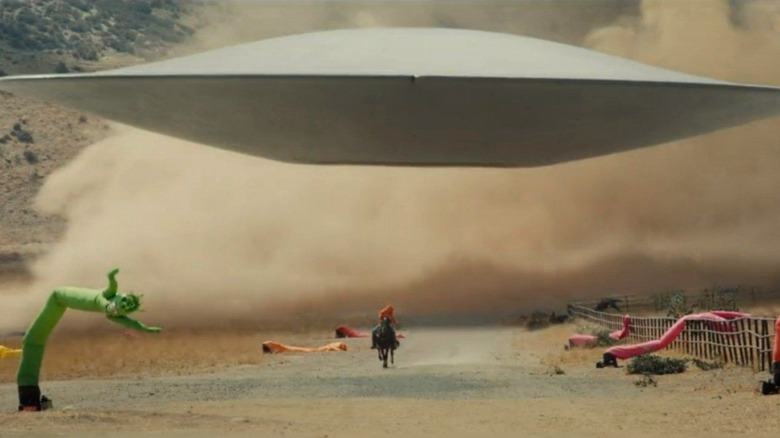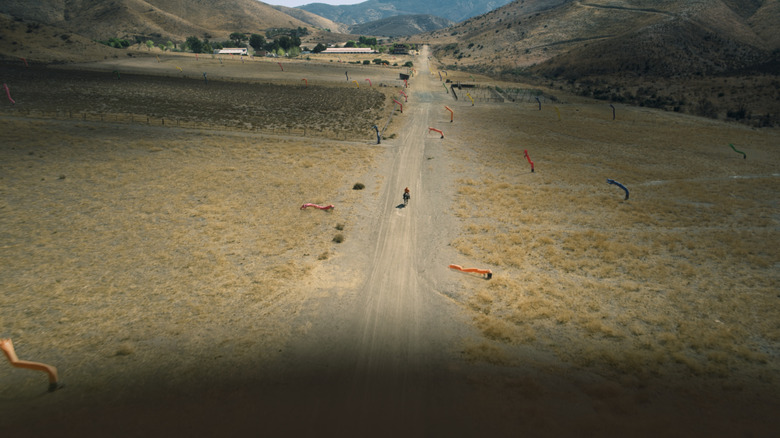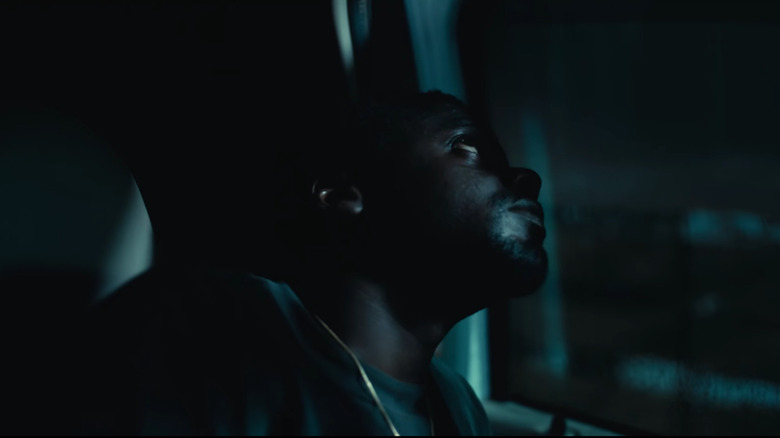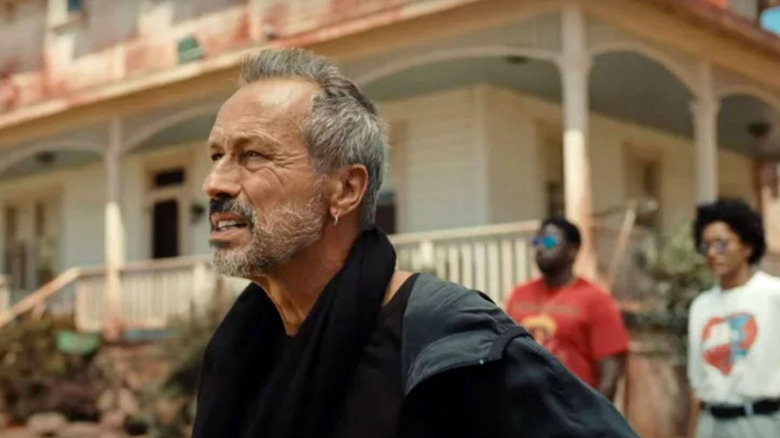Nope Sound Designer Johnnie Burn On Balancing Realism And Spectacle [Spoiler Interview]
Johnnie Burn is one of the mad geniuses behind Jordan Peele's "Nope." Burn, who knows his undeniably fantastic name sounds like it belongs to a rock star, is the sound designer, re-recording mixer, and supervising sound editor responsible for the science-fiction film. For a movie that blends horror, comedy, fantasy, and family drama, Peele's original story left Burn a lot of room to play.
With only a few notable locations, Burn helps create a vast world full of mystery in one extraordinary valley in California. He wanted truly alien sounds, as well as to capture the beauty and fear that nature can inspire. "Nope" isn't the first time Burn has created a lush, almost otherworldly soundscape: He previously worked on "Under the Skin" and "The Favourite." Recently, the acclaimed sound designer told us about his collaboration with Peele, crafting some of the film's standout sequences, and some of his theories about Peele's enchanting mysteries.
'Scripts don't get better than this for sound'
Both Nicholas Monsour and Michael Abels sung your praises last week.
Oh wow. Yeah, we had a great team on this. We were very lucky. It's been an honor to work on it. I mean, it's a dream job for sound. It's got all the ingredients you would want to have. When I first read the script, I thought, "Wow, scripts don't get better than this for sound, in many ways."
How so?
Well, not only does it have a kind of immersive soundscape, but it uses sound very well to progress the narrative, at times. There are so many times when what you are being scared by or what is driving the narrative forward is something that you're only hearing, and Jordan's really explored that interesting space of never giving you a picture that's as scary as the one you can imagine in your head, because it's more personal to you. I think for a lot of reasons, this film uses sound very well, and the biggest reason for that has got to be the script writing.
You created some truly alien sounds in this, where you're not sure whether it's a sound effect, score, or environment at times.
It does have that effect, doesn't it? In a film like this, in a blockbuster, you'd have the score come in and all other sounds would give way to that and that would be the narrative force. Here, in the last half hour of this film, the film does that, but it still has space to include the idea that you still feel that you are really there and you're not watching a succession of images with music. You're still very much in the reality of the space, as kind of helped by the sound, I think.
When you see it in IMAX, you really hear it in your bones.
We did the main mix in Atmos and then you do the variants the week afterwards, and the IMAX mix was a real fun day because you can just go crazy with the bass. It has the facility to give you full spectrum bass — not just from the front wall as tends to be with most sound systems, but you can have bass behind you.
The shot where you have the alien POV looking back at you, exclaiming just before the abduction, it is just like, "Wow, we could actually do this." I mean, thanks to [cinematographer] Hoyte [van Hoytema], there are so many shots where your POV is like that, and the sound from where we are is above us, you know? And so, it's a true Dolby Atmos spectacle. The ability to have so much height information as a necessary part of the storytelling was an amazing boon.
It's not big for the sake of big, either. Just these little pieces that create a big effect.
Yeah, no, everything was firing, right? The first time you are out at night with OJ and he's standing there, a man with his horse and looking out into the incredible nightscape of that wonderful cinematography, we had the opportunity to really create that space and hear it and play with how you hear things at a distance. Even things like where Kiki shouts, "We're setting up a decoy for horse training!" and the way you hear those things echo around, and by that point in the film, you're really used to that sound language of the film. Everything has a slight bouncy echo to it. And then you're familiar with the distances, and that really helps.
It can be so difficult in a film like this to have the geography correct. I think in that blockbuster last half hour, I think everyone actually really gets where [the characters] are, where the things are taking place, and the narrative geography of it. I think sound sort of helped with that.
How was it working on the more quiet scenes, just depicting life on the Haywood property?
I went down there last August and I would hang out with the security guard at night, after the crew had gone home. It would be quiet and the guy was telling me, "Yeah, there's an owl that turns up at about 4:00 a.m.," you know, so I'll wait for that. A lot of it is the veracity of what it actually sounded like.
On top of that, there are these other sound designs, almost a motif in the film: The wind screams a little sometimes, and you're not sure if you're hearing wind that whistles, or is it that slight misdirect of screams? And then you start to learn that's a more quite horrific thing through the film.
A lot of it was trying to find a credible sound for that valley, so that we would believe we are standing there. And then we can place into that the narrative elements of the sound design. It was really important to me, because there are some really loud bits in the film, but there is a bit where he stands there with his horse and it's super quiet and you can hear the trees rustling. I went and recorded the actual tree that was there, and all the footsteps around him there are the actual boot noises. I wore big boots. You hear that in great detail. You hear the horse and when the horse moves, you can hear the foley, the leather and the bridle and the bit, really quite loud, and that basically is telling your subconscious that it's super quiet out there, the fact that all the quiet sounds are loud.
I think Jordan was always describing it as, "I want to feel like I'm a kid and I'm outside my house at night," and that feeling of, "Wow, the big outdoors." I think we got pretty close to doing something good with that.
Did the owl make the final cut?
The owl did actually make it into the establishing shot, after the opening Gordy sequence bit, where you see the house at night. I think it's just after the, "A Jordan Peele film" title. Then we fade up on the house and that's the 4:00 a.m. owl, right there. I played it to Jordan, along with some coyotes in the background. I was like, "Is that too much?" And he said, "No, no, this is a film about animals. It's good, we can do that."
'I sat in my car outside my house with microphones and had my kids throw buckets of water over the car'
When OJ is in the car and looks up at the creature above him, there is so much going on in that sequence. How did it come together for you?
It's extraordinary, isn't it? The rainstorm comes over from the house and comes towards OJ. And that's a dream for sound in terms of Atmos, because the rain wall comes over the roof of the car. For that, I sat in my car outside my house with microphones and had my kids throw buckets of water over the car and spray it with a hose. So that's the basis of the beginning of the sound, but then once it becomes heavy, you're given the impression of an enormous wall of rain, like a ton of bricks. So then we added in a load of fire hoses and thunder banging and stomping on metal stuff.
I think what's really key is that it goes to silence. I mean, there's an awful lot of use of silence in this film for dramatic effect. Yeah, that just puts your heart in your mouth, doesn't it? ... In all of those monster sounds, I was trying to, as the film went on, give a bit more personality to it. So, at the end, after the monster growls at him, and then when he shuts the door, I tried to make the growling after that almost sound like the monster's mocking him. Get a bit of a laugh in there, yeah. It's shocking how funny, scary, and loud it is. A lot of that's just the difference between giving yourself the space to have the dynamic range, so you can go from silence to about as loud as you can go in a cinema. Max effect, you know?
Also, just throwing it out there, is it even an alien? We don't know if it came from Earth.
Yeah, yeah, yeah, totally. Yeah, no, it could well be. Or maybe it just came out of the sea. There is so little we know about the Mariana Trench. You have to wait for the sequel to find out. [laughs]
Since the movie is about respecting nature and the beauty of creatures, how did you want the creature to also inspire beauty and awe in the end, not just fear?
It's weird, because at first, I was trying to be terrifying and Jordan corrected me: "No, this is the animal being a spectacle." What's happening there is the animal being like, "Look at me," trying to show off even more. It's not quite a mating dance, but it has that element to it. It's trying to be the most alluring, beautiful, and therefore, hopefully sonorous beauty, as well, that it can muster.
Every way we described the animal before that point was with winds. Less so the wind it actually makes, but more the disturbance that it makes in the environment that it's in. So, like when OJ is in the gulch earlier and when we first see the horse getting abducted or hear it, you know what you're hearing then is the wind and the bushes blowing around, and that gives you the presence of the monster. We carried the wind theory through, but I used winds and winds with whistles and pitch tuned the frequencies of them, just so that they started to become vaguely musical and vaguely beautiful. They had a very slight chord structure to them, so that you start to think, "Oh, that's that chord sound, that's become slightly beautiful." In the end, that's the monster saying, "Look at me. I can be beautiful, you can look at me. Now you're in trouble."
Obviously, the creature is very far up in the sky when it is destroyed, so how big did you or could you go with its destruction?
To be honest, Jordan's been telling me to restrain myself for about a year now. My stuff is like, "Yeah, more, louder." I was like, "Wow, we can really blow it up." I remember we did a test screen and people weren't sure that the alien had died. Well, it was [a] different [version of it], and I said, "That's easy, we just make the sound really loud," and Jordan was like, "No, no, we don't. We make it definitive and we don't need to be too unsubtle about anything." It was just too hard to resist the urge to make a big old rubbery pop, with the thing.
For me, a lot of the film is about hearing sounds within the space that they're in more than hearing them, per se. So, the end explosion is about hearing it ricocheting around the valley and this scale of the space, more than the actual sound. I think that's a lot of what's going on with the sound in the film.
Is that a fine line to walk, especially for a movie like this? Being realistic, but also, this is a spectacle and this is a popcorn movie.
I know! The barn sequence, when OJ first encounters the aliens, in the barn. So we tried that with the score, but then one of my teammates added sprinkler sounds from where the film starts. You see the sprinkler, and so we used that, and obviously it's envisioned that the sprinklers are on, you can't just see them [in that scene]. We kind of heightened that and made the sound of the sprinklers become a tense rhythm.
A year ago, there was this thing on TikTok my daughter was showing me, with the "save the turtles" thing, that was a meme or something and it sounded really weird, but my daughter was doing that and it sounded a bit like the sprinklers. So, I recorded her doing that and then cut the S's out, and then it sounded really weird. It sounded like the alien kids were riffing off the environment that they were in, sound-wise, to sound convincing like an alien together, to scare OJ.
To answer your question, I think there is a way to use natural sound, and that's what I tried to do and to hit it quite hard and subvert the emotional narrative or whatever. I think, again, it's having a director who's open to the opportunity and having a script that says that right from the very beginning, you learn that the sound details are important. As an audience member, I may be popcorn munching, but I'm going to pay attention to the details and the sound, because I've learned that's where the clues are.
I did not expect that TikTok would be an influence for "Nope."
[Laughs] I know!
'I don't think I've ever worked with someone with such a rich voice'
Let's talk about the opening shot of the shoe and the "Gordy's Home" sequence. Obviously, the shoe is very important, maybe when the creature first arrived, but with an image like that, how did you want to or not want to communicate its importance with sound?
It's great, isn't it? It's such a weird thing to happen, isn't it? I mean, directors don't have conversations with their crew where they explain in plain obvious terms. You're here to interpret and participate and put your thing in and have a go. And so for me, that has always been just a weird standout moment of Jupe's time here on Earth, where for some reason, he focused on that, and it's almost like he thought that was the really important thing about what was going on in his trauma immersion.
The sound in that scene is horrific. Gordy is behind the couch, we're not actually seeing what he's doing, but you're hearing it, and in some ways, that's grim. Again, that was just about removing the sound that was there. We hear a slight, tiny bit of feedback from whatever microphone Mary Joe might still be wearing, from the production.
For Gordy, for the most part, you're actually just ripping apart lettuces and vegetables, so it doesn't feel too bad, but oh, gosh. Again, all of that, the first one we did, I had alarms going off in the background and chaos and hearing people and much more munching sounds and much more whimpering and much more monkey noises. Jordan was like, "Yeah, great, but take away 90% of all of that. It's much more horrific to spoon-feed people tiny little bits."
But yeah, stand out, weird moment. Do you see that the alien made the shoe stand up?
Yes. The power went out. Like the horse, Gordy acted territorial, that's how I saw it.
Yeah, yeah.
Maybe it's when it first arrived, but maybe it was in California a long time before the show.
No, we definitely had these conversations, yep. Yeah, that could well have been the day Jean Jacket entered Earth's atmosphere. I've got a few theories, but that's definitely one of them, yeah. It wouldn't be wrong, I think. I think there's many ways you can read it. There are certainly layers to this film, aren't there?
My interpretation of the movie changed quite a bit on second viewing.
Yeah, yeah. I've had people say, "It's really good, the second half is great, but the first half is a bit slow." And I've heard people say exactly the opposite, as well. It's one of those polarizing movies, isn't it?
It means it's ambitious. How was it creating the sound of a film set for the commercial shoot?
Those things tend to be innocuous conversation-based, and also the soundstage doesn't actually have any echo in it, because that's the whole point. So, it's a very dry sound. It's almost a bit of a library atmosphere. We did record a lot of loop groups. Dhyana Carlton-Tims, who is the ADR supervisor, put a lot of effort into them. Also, it's different conversations and we put them around the speakers, the shot, and then, "Hang on, it gets a bit distracting if it's all in the rear," so you bring it back around to the front.
Mostly what we were trying to achieve there was attenuating the moment of OJ's meltdown, when he gets asked to make his speech, and then of course, the building up the horse kick, kind of thing. So, for the most part, it was working out how to use the sounds to affect the tension there, because that's score-free, that scene.
One of the greatest sound effects in this movie is Michael Wincott's voice. How was it working with his voice?
I know, God, and when he does Purple People Eater speech ... the first time I mixed the movie, I didn't put a lot of bass into voices, and then, when I mixed Yorgos Lanthimos' "The Lobster," I played him the first draft that I've done of it, and he was like, "No, the voices are too soft. You know like when you're a kid and you're in the back of the movie theater and all you can hear is the voices?" I was thinking, "Hmm, 'Cinema Paradiso.'" Yorgos got me into putting bass into voices.
With Wincott, it's just another level, isn't it? That powerful speech, and again, the fact that we pulled out all the additional sounds, the winds and everything, and the score has a lovely refrain in it. I think there was one tiny bit of camera noise at that point, and so, Michael had to come in and ADR one syllable, just to get rid of a bit of noise. I don't think I've ever worked with someone with such a rich voice.
It's such great casting, too. We don't see him all the time in movies, so his presence is mysterious and special.
Oh, my God, yeah. And doing the ADR section, we had to do it in Zoom, even though I was in the room next door for Covid rules, but just watching him do the bit where he gets abducted and he's going, "Ahhhhh!" [laughs] I've got great videos. It's just hilarious. It's almost as entertaining as the scene itself.
Yeah, he's a real character. He talks just like that in real life. I actually, foolishly, thought he was kind of putting it on to some degree, for the movie, but then, when I met him, he was like, [Wincott voice] "Hi, Johnnie, good to meet you." I was like, "Wow! I want that voice."
With the pills and the cough, the cinematographer is dying in the movie, right? He goes out getting that one last great shot?
That's definitely how I read it, yeah. Again, it's breadcrumbs, isn't it? It's like if you want to piece it together that way, then do, but I think he was quite happy to go out on his last shot, while the tide is still in, preferably.
"Nope" is now playing in theaters.



